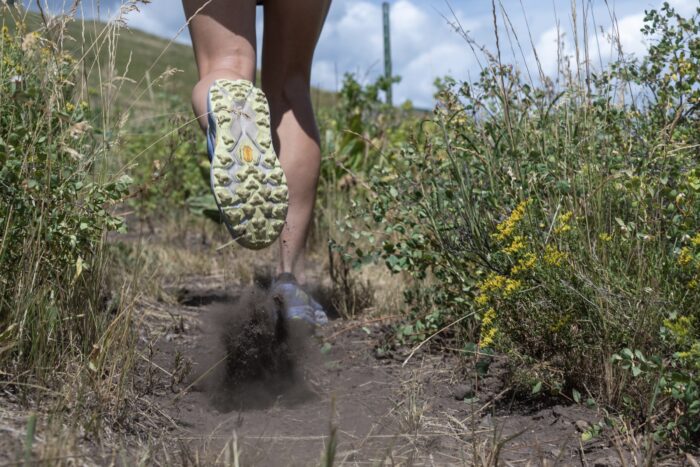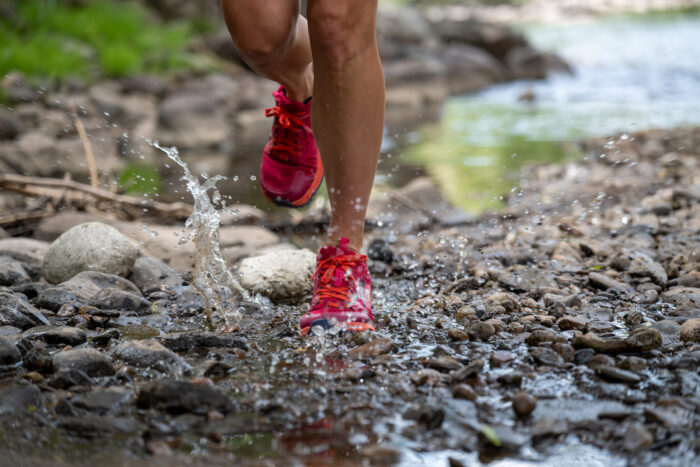Sure, you could get away with wearing normal sneakers on the trail, but having a pair of trail-specific running shoes provides increased comfort, grip, and protection from rocks and debris. From the forest trails of the American South to the rocky peaks of the Pacific Northwest, we spent months running, hiking, and testing to find the best trail running shoes for women.
While testing, we focused on choosing a variety of shoe styles to fit each runner’s needs and feet — because the shoe each trail runner needs is as unique as the trails they run.
Whether you prefer the minimalist feel of the Merrell Trail Glove 7, the extra cushion of the Hoka Speedgoat 6, or the extreme grip of the Brooks Cascadia 18, we’re confident you’ll find a new favorite running shoe here. Get ready to lace up and hit the trails.
Our current author, Constance Mahoney, is an avid runner who has completed distances from local 5ks to trail ultramarathons. She recently heavily revamped this guide, testing over 10 different trail shoes and making sure only the most deserving, current selection is represented in this guide
Editor’s note: For our March 7, 2025, update, we’ve covered the latest versions of some trail-worn favorites — the Brooks Cascadia 18, the Topo Athletic Ultraventure 4, and the Hoka Speedgoat 6.
The Best Women’s Trail Running Shoes of 2025
- Best Overall Women’s Trail Running Shoe: Salomon Sense Ride 5
- Best Budget Women’s Trail Running Shoe: Asics Trail Scout 3
- Runner-Up Best Women’s Trail Running Shoe: Brooks Cascadia 18
- Best Wide Toebox Women’s Trail Running Shoe: Topo Athletic Ultraventure 4
- Most Comfortable Women’s Trail Running Shoe: Hoka Speedgoat 6
- Best Women’s Trail Running Shoe for Mud: Brooks Caldera 7
- Weight (per pair): 17.4 oz.
- Drop: 8.3 mm (29.6/21.3 mm)
- Upper material: Textile/synthetic
- Best for: Long or short runs on mixed-terrain or urban trails
Pros
- Highly breathable
- Single system lacing
- Great traction for various terrain
- Excellent support
Cons
- Rigid
- No rock guard
- Snug fit
- Weight (per pair): 18 oz.
- Drop: 10 mm
- Upper material: Abrasion-resistant mesh
- Best for: Town-trail shoes, hiking
Pros
- Affordable
- Great heel lockdown
- Vegan
- Road to trail transition
Cons
- Heavy
- Stiff
- Weight (per pair): 19.8 oz.
- Drop: 8mm
- Upper material: Recycled mesh
- Best for: Trail races, long runs, all-in-one trail shoe
Pros
- Gaiter attachments
- Aggressive lugs
- Responsive
- All-trail shoe
Cons
- Heavy
- Wide sizing limited by color
- Weight (per pair): 16.6 oz.
- Drop: 5 mm (35/30 mm)
- Upper material: Recycled mesh
- Best for: Trail running, hiking
Pros
- Great for those who prefer wide toebox
- Maximum cushioning
Cons
- Lightweight
- Gaiter compatible
- Weight (per pair): 16.4 oz.
- Drop: 5 mm (38/33 mm)
- Upper material: Recycled engineered mesh
- Best for: Regular runs, trail races, and dry technical scrambles
Pros
- Offers wide sizes
- Highly cushioned for comfort
- Great at draining water
- Vegan
Cons
- Some of our testers don’t like the new, less stretchy upper
- Weight (per pair): 18.8 oz.
- Drop: 6 mm (26/20 mm)
- Upper material: Air Mesh
- Best for: Runners who want maximum cushion and comfort
Pros
- Aggressive lugs
- Incredibly comfortable
- Outstanding cushion
- Lace keepers
Cons
- Heavy
- Weight (per pair): 14.46 oz.
- Drop: Zero
- Upper material: 100% recycled breathable mesh
- Best for: Runners who want an affordable, bare-minimum shoe
Pros
- Affordable price
- Incredibly lightweight
- Keeps feet in a natural gait
- Barely-there feel
Cons
- Not ideal for rugged terrain
- Fits narrow
- Weight (per pair): 13.4 oz.
- Drop: 5mm (30/25mm)
- Best for: Trail races, fast trail runs
Pros
- Lightweight
- Aggressive lugs
- Responsive
- Very breathable
Cons
- Knit collar may be uncomfortable for some
- Narrow for a Hoka shoe
Women’s Trail Running Shoes Comparison Chart
| Trail Running Shoe | Price | Weight (Per Pair) | Drop | Upper Material |
|---|---|---|---|---|
| Salomon Sense Ride 5 | $140 | 17.4 oz. | 8.3 mm (29.6/21.3 mm) | Textile/synthetic |
| Asics Trail Scout 3 | $60 | 19.4 oz. | 9.4mm | Abrasion-resistant mesh |
| Topo Athletic Ultraventure 4 | $150 | 16.6 oz. | 5 mm (35/30 mm) | Recycled mesh |
| Hoka Speedgoat 6 | $155 | 16.4 oz. | 5 mm (38/33 mm) | Recycled engineered mesh |
| Brooks Cascadia 18 | $140 | 19.6 oz. | 8mm | Recycled mesh |
| Merrell Trail Glove 7 | $120 | 14.46 oz. | Zero | 100% recycled breathable mesh |
| Brooks Caldera 7 | $150 | 18.08 oz. | 6 mm (26/20 mm) | Synthetic air mesh |
| Hoka Zinal 2 | $160 | 13.4 oz. | 5mm (30/25mm) | Recycled polyester mesh |

How We Tested Women’s Trail Running Shoes
Our Expert Testers
Our Testing Process
Buyer’s Guide: How to Choose a Trail Running Shoe

Where You Run Matters
Identify Your Running Gait

- Basic, or neutral, pronation is different for everyone, but ultimately, neutral pronation occurs when your foot naturally rolls slightly inward to distribute the body’s impact upon landing.
- Overpronation occurs when your foot rolls too far inward, which means your shoes will show signs of wear on the insides of them.
- Supination, or underpronation, occurs when your feet roll outward, resulting in the outer part of the heel striking the ground first, which will show signs of wear on the outermost edges.

Stack and Heel-to-Toe Drop

Cushion

Stability
Rock Plate
Flexibility


Breathability
Waterproofing

Materials

Lugs and Traction

Weight

Price & Value
Budget
Mid-Tier
Premium
Frequently Asked Questions
With so many options to choose from, it can be challenging to choose the right trail shoes. Here are three things to consider as you shop:
- Set realistic running goals. If you dream of running a 100-miler one day but realistically will use the shoes for 5-mile training loops around your local park, buy shoes for the latter use first.
- Consider shoe width. For folks with wide feet, or those running very long distances, a wide forefoot can be a bonus that lets toes splay. The downside is that wider shoes are less precise, can be a little more clumsy, and won’t fit well on people with narrow feet.
- Test out the tongue. Does it fit comfortably? Will it keep rocks out of your shoe?
For more help choosing, check out our complete buyer’s guide to choosing a trail running shoe.
Stack and Drop
Unless you’re running barefoot, every shoe has a stack. Measured in millimeters, the stack refers to how high the insole sits off the ground. Shoes with more cushion inherently have a higher stack. Furthermore, most shoes have a “drop” in stack height from the heel to the toe.
If you’re new to running, experts recommend a lower heel drop; it builds a wider range of motion and strength, which makes you a healthier runner.
Cushion
Stepping into a high-cushion shoe can feel like walking on a cloud. Those running longer distances (or who supinate) will prefer more cushion to damp the repetitive pounding and provide support. But it can become a penalty. Extra foam adds extra weight.
So, is more cushion better? Not always. It’s about finding the right balance between speed and comfort. If you’re aiming for a new PR, look for a light, stiffer shoe with a harder cushion and minimal lug friction.
Flexibility
Flexibility is your friend on the trails. You need variability to match the variable terrain. Trail runners will prefer a shoe with a firm outsole and less cushion but a firm toebox to push off of. Flexibility and torsion can help the foot adapt to the trail and prevent injuries.
The life of a shoe depends on a variety of factors, including running style, weight, and how often they’re used. But in general, 300 to 500 miles is a good rule of thumb.
So, if you run 10 miles per week, your shoes could last 8 months to a year. If you’re logging 20 miles per week, plan on replacing your running shoes every 4 to 6 months.
And if you see excessive wear patterns, holes, or tears — or if you notice a decrease in footbed comfort — it’s probably time to grab a new pair of sneakers.


The Best Winter Running Shoes of 2025
We tested the best winter running shoes of 2024. Check out top picks from HOKA, Brooks, La Sportiva, inov-8, and more.

The Best Hiking Shoes of 2025
We tested and ranked the best hiking shoes for men and women for 2025, including top picks from Hoka, Salomon, Merrell, SCARPA, and more.
































